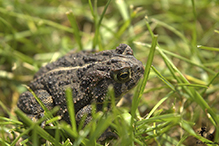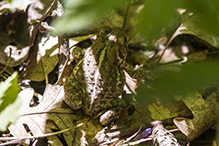American toad
(Anaxyrus americanus)
Conservation • Description • Habitat • Biology • Distribution • Taxonomy
|
|
||||||||||||||
Description |
American toad is the most common toad in Minnesota. It can be 2″ to 4″, averaging 3″, at maturity. The background color is usually brown, rarely greenish, red, or gray. There are 3 or 4 pairs of brown to black spots, sometimes bordered in white, on the back. There is often a pale line down the center of the back. Each spot contains 1 or 2 large warts. There are 2 cranial ridges between the eyes. These ridges do not join at the front or back. There are 2 large swellings behind the eyes. These are the paratoid glands, which secrete a toxin to discourage predators. The belly is pale with dark spots. The throat of the male is dark. |
Size |
|
Voice |
The call of the male is a high-pitched trill lasting 10 to 30 seconds. The pitch remains constant throughout the call, it does not rise. Other toads may answer with an overlapping call in a the same or a different pitch. |
Similar Species |
Canadian toad (Anaxyrus hemiophrys) background color is lighter, white or light brown. The warts on the back may be black, brown, or reddish. The 2 cranial ridges join at the rear to form a prominent bump (boss). In Minnesota it is found only in the west-central and northwest regions. |
Habitat |
A wide variety of habitats, from forests to prairies, with semi-permanent water adjacent to dense vegetation. |
Biology |
Behavior |
|
Lifespan |
5 to 8 years |
Life Cycle |
Eggs are laid in the early May. Larvae hatch in 3 to 12 days. The tadpole stage lasts 40 to 70 days. Toadlets emerge in late June or early July. Sexual maturity is reached in 2 or 3 years. Most individuals do not survive the tadpole stage. Those that do may reach 10 years of age, but most reach only 5 to 8 years of age in the wild. Adults hibernate in the coldest winter months and may aestivate during the hot, dry months of summer. |
Tadpole Food |
Algae, plant tissue, organic debris |
Adult Food |
Small terrestrial insects and other invertebrates |
Distribution |
||
|
Sources 7, 14, 24, 29, 30, 73, 76, 78. Biodiversity occurrence data published by: Minnesota Biodiversity Atlas (accessed through the Minnesota Biodiversity Atlas Portal, bellatlas.umn.edu, 5/2/2024). |
|
| 5/2/2024 | ||
Occurrence |
||
Common and abundant |
||
Taxonomy |
|
Class |
Amphibia (amphibians) |
Superorder |
Batrachia (amphibians) |
Order |
Anura (frogs and toads) |
Suborder |
Neobatrachia |
Superfamily |
Hyloidea |
Family |
Bufonidae (true toads) |
Genus |
Anaxyrus (North American toads) |
This species was formerly classified Bufo americanus. In 2006 all North American true toads (family Bufonidae) were transferred out of the genus Bufo by Frost et al., and several new genera were created. |
|
Subordinate Taxa |
|
dwarf American toad (Anaxyrus americanus charlesmithi) eastern American toad (Anaxyrus americanus americanus) Hudson Bay toad (Anaxyrus americanus copei) |
|
Synonyms |
|
Bufo americanus |
|
Common Names |
|
American toad |
|
Glossary
Aestivate
A period of reduced metabolic activity in the summer, similar to hibernation.
Visitor Photos |
||
Share your photo of this amphibian. |
||
This button not working for you? |
||
Alfredo Colon |
||
 |
 |
|
 |
 |
|
 |
 |
|
 |
 |
|
 |
 |
|
the size of a quarter They were sunbathing on leaves. |
||
Jessica Claire |
||
Frog expert? I made a frog pond in the spring, however there are still many tadpoles (and snails) in the water. |
 |
|
I am now aware some overwinter as tadpoles, but the pond is no deeper than 2'. I do have a sheet liner in the pond, for what that's worth. |
 |
|
I don't want to kill any of the life in the pond, so I'm very open to suggestions! Thank you very much in advance! |
 |
|
John Beltman |
 |
Bill Reynolds |
||
 |
 |
|
 |
 |
|
 |
||
Brian Blom |
||
 |
 |
|
Wayne Rasmussen |
||
American toad found in Nerstrand Big Woods SP a few years ago. Hiking here will usually provide wildlife of some kind or flowers in the spring. |
 |
|
This is one of Minnesota's best known herp species. Adults are 2 to 3 1/2 inches snout to vent. The ground color is highly variable, but it is usually a shade of brown. Rarely it is gray, red, or greenish. There are black spots on the back. These spots contain one or two warts. These black spots often have a white border. They have an oval partoid gland behind each eye. The belly is white or yellowish and is heavily mottled with black. There is usually a light mid dorsal stripe down the back. |
 |
|
MinnesotaSeasons.com Photos |
||
 |
 |
|
 |
 |
|
 |

Slideshows |
|

Visitor Videos |
||
Share your video of this amphibian. |
||
This button not working for you? |
||
Dan W. Andree |
720p "Color Variations in the American Toad" filmed by Dan W. Andree 2015 |
About
Published on Nov 11, 2015 This brief video shows two color variations of the American Toad. One little toad was cranky. Though it may look like I'm teasing it I was trying to cheer it up. As you will see it didn't work and I left the little toad alone. Hopefully its following day was better. |
Other Videos |
||
Eastern American Toad (Anaxyrus americanus) |
About
Published on Apr 30, 2012 WI Frog and Toad Survey: http://wiatri.net/inventory/FrogToadSurvey/ WDNR Eastern American Toad profile: http://dnr.wi.gov/org/land/er/biodiversity/index.asp?mode=info&Grp=21&SpecCode=AAABB01020 |
Eastern American Toad Tadpole Die Off |
About
Uploaded on Jan 25, 2012 In this 2 minute scene from Expedition New England's episode #86 Scott Tucker and his family stumble upon a die off of thousands of Eastern American Toad tadpoles in a Vermont river bed . This was a very unexpected breeding area since these amphibians are usually found in vernal pools that are isolated from fish habitat. Was this a sign of climate change where our aquatic environments are drying up too quickly or was it just a typical seasonal fluctuation? Either way the fact remains that thousands of these creatures never metamorphosed into toads and their gene pool is gone. |
American toad calling |
About
Uploaded on Mar 20, 2009 American toad calling |
American toads calling 2 |
About
Uploaded on Dec 19, 2009 American toad calling from a flooded stream. |

Visitor Sightings |
||
Report a sighting of this amphibian. |
||
This button not working for you? |
||
| Alfredo Colon 8/21/2022 |
Location: Albany, NY |
 |
| Alfredo Colon 8/21/2022 |
Location: Albany, NY |
 |
| Alfredo Colon 8/18/2022 |
Location: Albany, NY |
 |
| John Beltman 6/17/2022 |
Location: Woodbury, MN |
 |
| Alfredo Colon 6/2/2021 |
Location: Woodbury, MN |
 |
| Alfredo Colon August 2019 |
Location: Slinger, Wisconsin |
 |
| Alfredo Colon 7/2/2018 |
Location: Woodbury, Minnesota the size of a quarter They were sunbathing on leaves. |
 |
| Bill Reynolds June 2018 |
Location: Pennington Co MN |
 |
| Brian Blom 8/24/2017 |
Location: Crow Wing County, Deerwood |
 |
MinnesotaSeasons.com Sightings |
||

Created: 8/8/2009 Last Updated: © MinnesotaSeasons.com. All rights reserved. |



